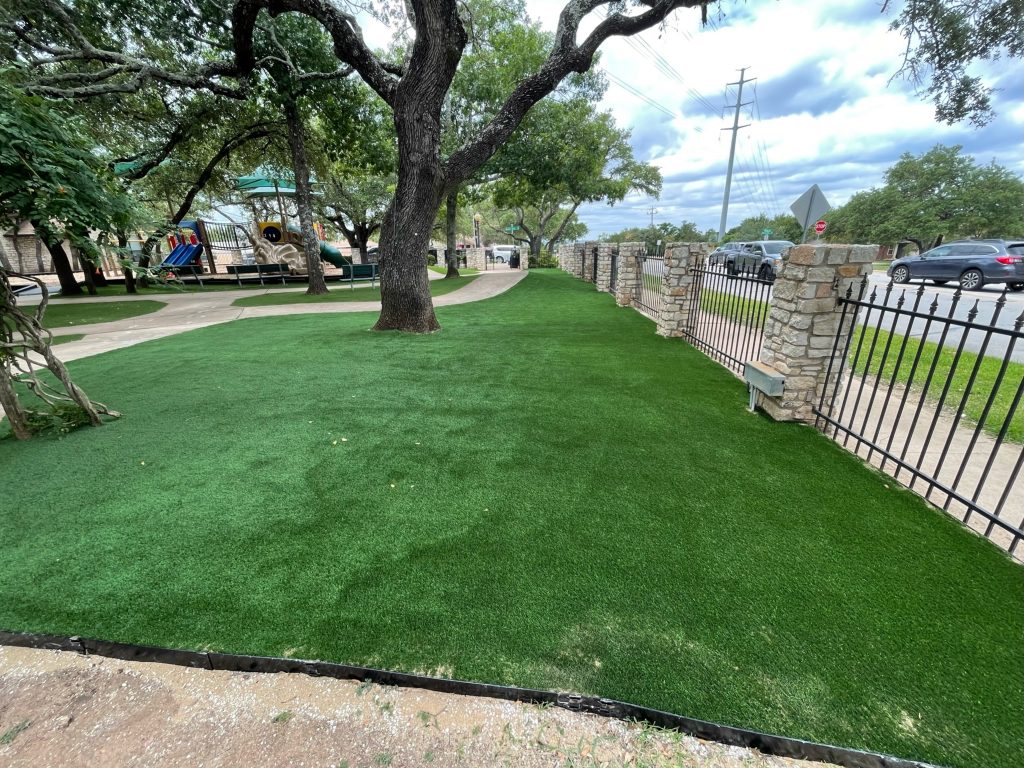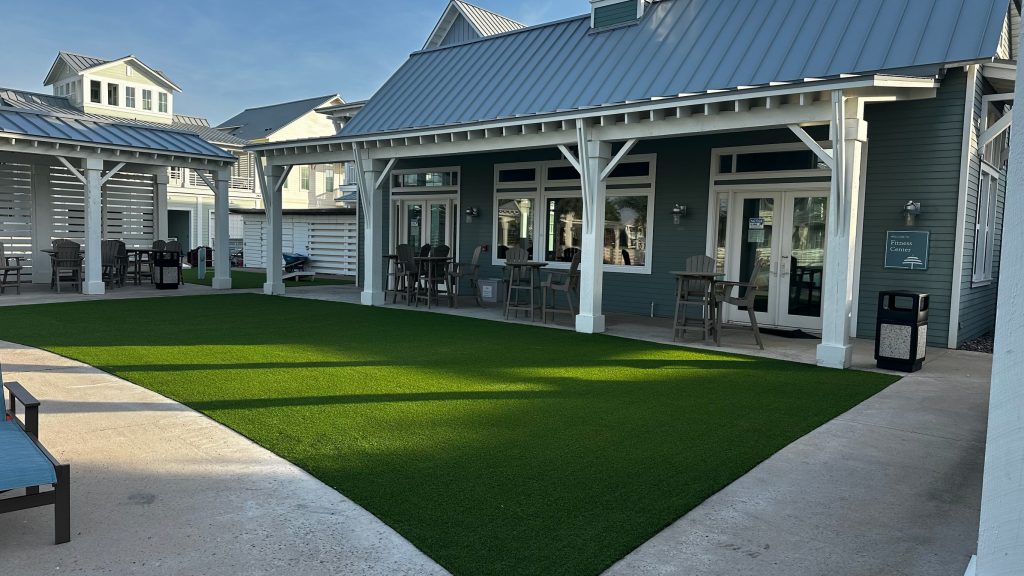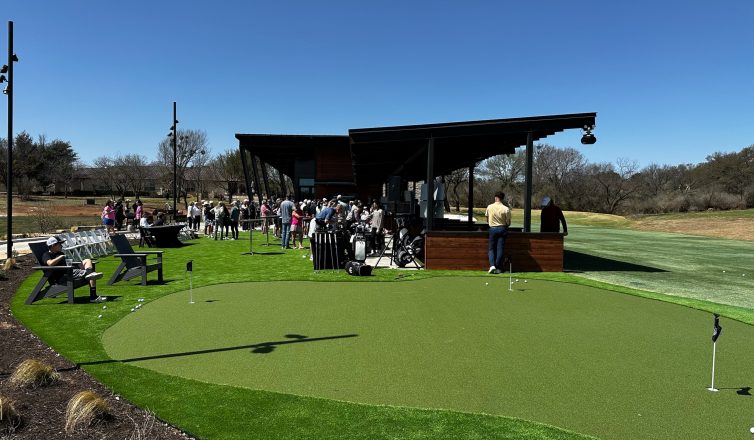In today’s schools and public spaces, keeping outdoor areas beautiful, safe, and usable all year is no small feat. Constant foot traffic, unpredictable weather, budget constraints, and labor shortages make it tough to maintain natural grass. It’s no wonder that more districts, parks departments, and municipalities are choosing artificial turf as a long-term solution.
Artificial turf offers a way to reduce costs while enhancing the functionality, safety, and appearance of public-use areas. At Lone Star Turf, we specialize in premium installations designed to withstand Texas heat, heavy use, and the high standards required by schools and public agencies.
Let’s explore where artificial turf makes the biggest impact and how it’s reshaping community spaces across the South.
Quick Summary
- Turf withstands heavy traffic, reduces maintenance, and conserves water.
- Provides safer, ADA-compliant surfaces for playgrounds, athletic fields, and public areas.
- Enhances year-round usability for schools, parks, dog parks, and event spaces.
- Improves aesthetics, eliminates mud, and supports eco-friendly initiatives.
- Pays for itself in 3–5 years through reduced labor and irrigation costs.
- Backed by Lone Star Turf’s professional installation and industry-leading warranties.
Why artificial turf for schools and public spaces is ideal
Switching from natural grass to artificial turf isn’t just a cosmetic choice, it’s a strategic one. For schools and cities alike, turf solves several recurring issues:
- Durability & Longevity
Artificial turf holds up under heavy use, whether it’s hundreds of students at recess or a weekend soccer tournament. It doesn’t brown, die, or develop bald spots. - Enhanced Safety
Today’s turf systems include shock-absorbing padding and ADA-compliant surfaces, reducing injuries on playgrounds and athletic fields. - Low Maintenance
No mowing. No watering. No pesticides. Turf minimizes labor and material costs year-round. - All-Weather Use
Quick drying and minimal mud means fewer cancelled games, muddy shoes, or closed-off spaces due to rain. - Environmental Impact
Artificial turf reduces water usage and chemical runoff, supporting eco-conscious goals for schools and municipalities.
The result? More reliable outdoor spaces and more predictable budgets, all while improving how these areas look and function.

Where turf makes the biggest impact at schools
From playgrounds to courtyards, turf for schools delivers measurable value across a variety of spaces.
Playgrounds
One of the most common applications, turf provides a soft, level surface for playgrounds, reducing scrapes and injuries. Unlike mulch or gravel, turf doesn’t scatter or require frequent replacement. It stays consistent, clean, and accessible to children of all abilities.
Athletic Fields and Tracks
Artificial turf is ideal for athletic fields, PE classes, recess sports, and after-school programs. It creates a uniform playing surface for sports like soccer, football, and kickball—especially helpful for campuses that host community leagues or tournaments.
Outdoor Courtyards and Assembly Areas
Turf makes open campus areas more inviting and usable. Students can eat lunch, attend assemblies, or just hang out on a clean, mud-free surface. No patchy grass. No brown spots.
Rooftop or Urban Play Areas
Many charter and private schools, especially in dense urban neighborhoods, have limited land. Turf makes rooftops and concrete courtyards feel like green space, expanding usable square footage in a safe, welcoming way.
Real-World Example: Lone Star Turf recently transformed part of an elementary school’s recess area. The PTA had raised concerns about injuries and mess. With turf in place, the school saw immediate improvements in safety and student enjoyment.
“Watching the kids when the bell rings after recess, they would just run through… and there [were] tree roots, it was half muddy, they would trip on it. So, just fixing the safety hazard was our first improvement. Second, I mean, look how beautiful it is! It just transformed this space into a beautiful, green, lush area that they can use not only for recess, but for classroom enrichment as well.” -Jill Luna
Where turf helps in parks and recreation spaces
Parks and municipal green spaces deal with similar issues—high foot traffic, uneven terrain, and demanding upkeep. Turf solutions help relieve the pressure on maintenance teams and create consistently welcoming public areas.
Community Playgrounds
Artificial turf ensures year-round usability with a soft, safe surface. It supports ADA compliance and eliminates issues like splinters, muddy runoff, and weed growth common with mulch or dirt.
Multi-Use Athletic Fields
Whether it’s baseball on Monday, flag football on Tuesday, or a youth soccer league all weekend, turf fields accommodate multiple sports with minimal downtime or field prep.
Picnic and Event Lawns
Turf provides clean, comfortable grounds for public events, festivals, or family gatherings. Unlike real grass, it doesn’t wear out after a weekend concert or barbecue.
Dog Parks and Pet Relief Areas
Pet-friendly turf resists digging, drains quickly, and is easy to sanitize. That means less mud and fewer complaints from pet owners and maintenance teams alike.
Other high-impact uses of artificial turf in public spaces
Artificial turf isn’t just for fields and playgrounds. Its versatility opens the door for creative applications across municipal and civic infrastructure.
Municipal Centers and Civic Plazas
Turf around government buildings, libraries, and police stations offers a clean, manicured look with zero landscaping headaches. It’s a subtle but powerful way to improve public perception and create welcoming community spaces.
Rooftops and Urban Courtyards
Green rooftops add value and calm in dense areas. Turf helps cities and businesses reclaim underused space and even comply with stormwater management goals.
Medians, Pathways, and “Problem Spots”
Traffic islands, roadside medians, or well-worn footpaths often struggle to grow grass. Turf thrives where natural landscaping fails—and dramatically reduces weed control, erosion, and reseeding costs.
ADA Accessibility
Unlike gravel or grass, turf supports wheelchairs, walkers, and strollers with ease. Public agencies appreciate that artificial turf helps meet compliance standards while enhancing visual appeal.

Why decision-makers choose turf: The long-term payoff
Artificial turf isn’t just a quick fix; it’s a strategic move that pays off for administrators, facility managers, and city planners.
Financial Efficiency
While the upfront cost is higher than seeding grass, the break-even point typically arrives within 3–5 years, thanks to savings in irrigation, fertilizers, mowing, and labor.
Year-Round Functionality
Because turf doesn’t suffer from rain delays or overuse, schools and parks can schedule events and activities with confidence.
Consistent Appearance
Turf always looks freshly mowed, even in drought or extreme heat. This supports community pride, attracts positive attention, and improves the public experience.
Reliable Warranty & Support
Lone Star Turf offers one of the industry’s strongest installation warranties, with professional crews and ongoing service for added peace of mind.
Starting your project: What to consider first
If you’re exploring turf for schools or public use, it’s essential to start with clear expectations. Consider the following before choosing a turf provider:
- Usage type: Will the area host athletic activity, recess, pets, or occasional events?
- Traffic volume: Daily recess demands different materials than a light-use courtyard.
- Safety and ADA requirements: Ensure the surface is compliant and inclusive.
- Cooling and drainage needs: Some areas benefit from cooling infill or additional drainage layers.
At Lone Star Turf, we provide free consultations to assess your space, recommend the right materials, and provide a clear installation timeline and quote.
Frequently Asked Questions (FAQ)
Is artificial turf safe for school playgrounds and public parks?
Yes. We install turf systems that meet or exceed national safety standards for fall protection, heat mitigation, and ADA accessibility.
How long does artificial turf last?
Most installations last 12 to 20 years, depending on traffic and maintenance.
Does turf get too hot in the Texas sun?
It can get warm, like concrete, but we offer cooling infill and design strategies to manage heat exposure.
What maintenance does turf require?
It’s low-maintenance—usually just occasional brushing, debris removal, and rinsing as needed.
What kind of warranty does Lone Star Turf offer?
Our installations come with industry-leading workmanship and product warranties. We stand behind every project.
Ready to Transform Your Campus or Community Space?
Artificial turf is more than a landscaping upgrade—it’s a way to improve usability, safety, and sustainability in the places people gather, play, and learn.
Whether you’re a school administrator, city planner, or facility director, Lone Star Turf can help you plan, design, and install the right turf solution for your space.
See how artificial turf for schools and public spaces can transform your community. Contact Lone Star Turf for a free consultation today.
